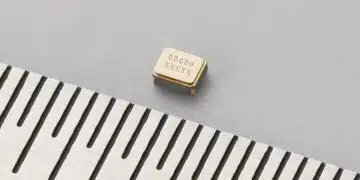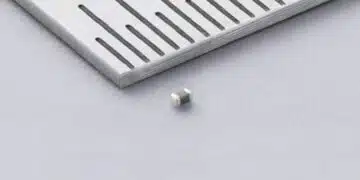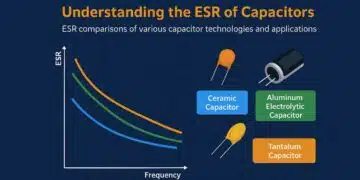KYOCERA has unveiled the KC1210A Series Clock Oscillators, which are ultra-compact and ultra-low voltage. These oscillators enable energy-efficient design for next-generation smartphones and wearables.
Kyocera Corporation announces the development of the KC1210A Series clock oscillators.
These oscillators offer the world’s smallest size*1 and operate at an ultra-low voltage of 0.9V, which is approximately 50% lower than Kyocera’s previous conventional clock oscillator models. Sample shipments are now available, with full-scale mass production planned for the summer of 2026.
Key Features:
- Ultra-compact design and low profile: 1.25mm × 1.05mm × 0.5mm max.
- Low-voltage operation: 0.9V, about 50% lower than previous models.
With the increasing functionality of smartphones and wearables, including AI, high-speed communication, and large-scale data processing, power consumption is also rising. This leads to faster battery depletion and more frequent charging. To address these issues, demand is rising for compact, low-voltage oscillators. In response, Kyocera developed the KC1210A Series. Kyocera will continue to innovate to meet market needs and support the evolution of advanced devices.
Background of Development
As smartphones and wearables evolve with AI, high-speed communication, and large-scale data processing, power consumption increases, causing faster battery depletion and more frequent charging. To address these issues, the demand for compact, low-voltage oscillators is growing. Kyocera developed the KC1210A Series to meet these needs, supporting the evolution of advanced devices.
Features of the KC1210A Series
Ultra-compact design and low profile
Kyocera’s proprietary compact element design2 achieves strong performance in a smaller form factor. The mounting area is reduced by approximately 60% to 1.31 mm2, and the volume is about one-quarter of the KC2016K model, supporting high-density device mounting.
Low-voltage operation: 0.9V
The newly developed oscillator IC enables operation at 0.9V, reducing power consumption by about 50% compared to previous models, supporting energy savings in smartphones and wearables.
Main Applications
- Smartphones
- VR Goggles / VR Headsets
- Wearable Devices
- IoT modules
KC1210A Series – Product Overview
| Product Name | Clock Oscillators |
|---|---|
| Model | KC1210A Series |
| Dimensions | 1.25mm × 1.05mm × 0.5mm (Max.) |
| Production Site | Higashine Plant, Yamagata, Japan |
| Mass Production | Scheduled for Summer 2026 |
| Operating Temperature Range | -40 to +85°C / -40 to +105°C |
Electrical Characteristics
| Output Frequency Range | 9.6MHz to 100MHz |
|---|---|
| Output Type | CMOS |
| Frequency Tolerance | ±25 × 10-6 (-40 to +85°C), ±50 × 10-6 (-40 to +105°C) |
| Supply Voltage | 0.8V to 1.8V |
| Current Consumption | 3.5mA (Max.) / 50MHz, 0.9V, CL = 15pF |
- * Frequency tolerance includes initial tolerance 25°C, operating temperature characteristics, supply voltage variation, load capacitance variation, aging (1st year 25°C), and effects of vibration and shock.
- 1 – Based on Kyocera research as of August 2025, among clock oscillators utilizing a ceramic package.
- 2 – Kyocera’s proprietary technology for designing compact crystal elements.






























